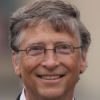Bill Gates

Bill Gates
William Henry "Bill" Gates IIIis an American business magnate, entrepreneur, philanthropist, investor, and programmer. In 1975, Gates and Paul Allen co-founded Microsoft, which became the world's largest PC software company. During his career at Microsoft, Gates held the positions of chairman, CEO and chief software architect, and was the largest individual shareholder until May 2014. Gates has authored and co-authored several books...
NationalityAmerican
ProfessionEntrepreneur
Date of Birth28 October 1955
CitySeattle, WA
CountryUnited States of America
(In response to Java) Anybody who thinks a little 9,000-line program that's distributed free and can be cloned by anyone is going to affect anything we do at Microsoft has his head screwed on wrong.
Microsoft Products are Generally Bug Free
Making sure all our students get a great education, find a career that's fulfilling and rewarding, and have a chance to live out their dreams ... wouldn't just make us a more successful country - it would also make us a more fair and just one.
Bill Gates' Success Factors for Microsoft 1. Long-term Approach 2. Passion for Products and Technology 3. Teamwork 4. Results 5. Customer Feedback 6. Individual Excellence
Two years from now, spam will be solved.
Long-term vision and product strategy.
There were a lot of missteps in the early days, but because we got in early we got to make more mistakes than other people.
We weren't trying to just go public and get rich. There was no near-term thing. It always was this many-decades thing where there were no shortcuts and we'd sort of put one foot in front of the other.
Reward worthy failure - Experimentation.
We can make market forces work better for the poor if we can develop a more creative capitalism-if we can stretch the reach of market forces so that more people can make a profit, or at least make a living, serving people who are suffering from the worst inequities. ... You have more than we had; you must start sooner, and carry on longer.
If you're too focused on your current business, it's hard to change and concentrate on innovating.
It's pretty incredible to look back 30 years to when Microsoft was starting and realize how work has been transformed. We're finally getting close to what I call the digital workstyle.
If the 1980s were about quality and the 1990s were about reengineering, then the 2000s will be about velocity.
The vision is that people should have the ultimate in convenience. Being able to get the things they care about on the appropriate device.